USBL Theoretics
This document deals with the computations using the measured Incidence Angle.
On this page:
Measuring Incidence Angle
USBL systems rely on a phase difference, or phase comparison, of the acoustic signal at the elements of the transducer in order to determine the angle of incidence of the acoustic signal with the plane of the transducer array.
Dealing with the single plane through two sensors of the transducer and the acoustic source, the figure below illustrates how the mechanical angle of incidence is determined from the phase difference measured between the two receiving sensors spaced a distance, b, apart.
If the baseline, b, is always much less than the distance to the acoustic signal source, the acoustic wave fronts are essentially planar and the mechanical angle is given by:
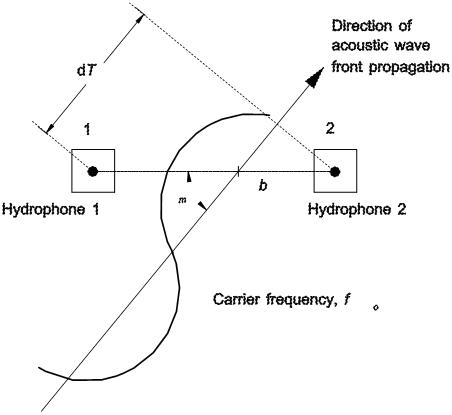
Tm = cos-1dT/k (where dT = electrical phase difference)
Tm = mechanical incidence angle
k = 2pfob/v (stiffness factor)
fo = acoustic signal carrier frequency
b = baseline length between sensors
v = velocity of sound in water
The incidence angle Tm can be visualized as the vertex angle of a conical surface whose axis is formed by the baseline of the two sensors.
Since direction between acoustic source and transducer cannot be determined from phase comparison between only two sensors, a third sensor is required within the transducer array whose baseline, formed with one of the first two sensors, is orthogonal to the first baseline.
Incidence angle measured for this second baseline, can again be visualized as the vertex angle of a conical surface whose axis is formed by the baseline of the two sensors.
The two angles of incidence are designated Tmx and Tmy. Direction between transducer and acoustic source is given by the intersection of the two conical surfaces as depicted in figure below.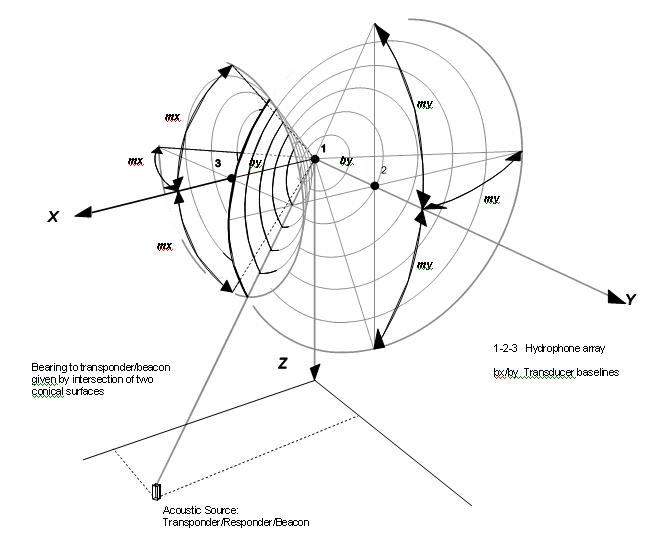
Although two directions result from such an intersection, one is easily eliminated since it is known that the acoustic source lies beneath the surface vessel. If one of the baselines of the transducer array is oriented in the direction of the vessel's centreline, and the vessel is considered motionless such that the transducer hydrophone array is horizontal, the planes of the array will be coincident with the "X", "Y", and "Z" axes of the local reference system. Having determined direction, apparent position of the sub-sea transponder /beacon can be computed if either depth or slant range is known. If both depth and slant range are known, there will be less uncertainty about the final computed coordinates for the transponder/beacon.
Position Computed from Incidence Angle and Depth
Range cannot be measured if the sub-sea acoustic source is a beacon. Therefore, to determine the position of the beacon with respect to the vessel-mounted transducer, the vertical separation of the two, h, must be known.
Moreover, since the incidence angles, Tmx and Tmy do not necessarily lie in the XZ and YZ planes of the array, a conversion may be required before the results represent horizontal displacements away from the reference beacon.
The apparent horizontal displacements Xa and Ya are expressed as a fraction of the vertical separation, h, and shown to be: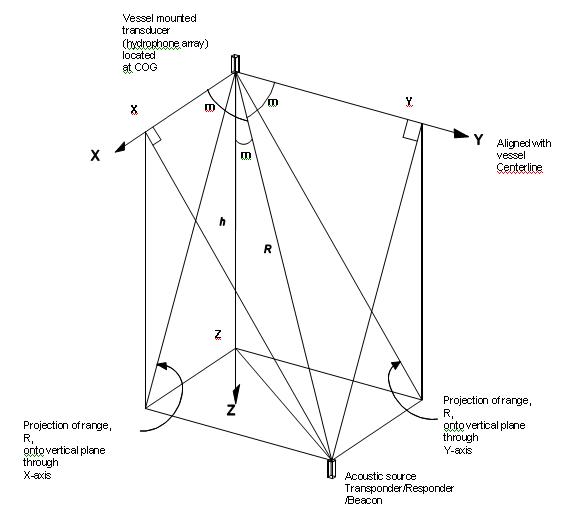
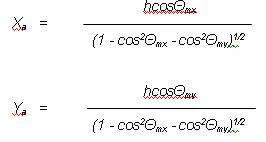
Position Computed from Incidence Angle and Range
If a transponder is used instead of a beacon, it can be interrogated by the transducer, and the two-way travel time determined. Range is then given by:
R = vt/2 (where t = time elapsed between transmission of interrogation pulse and reception of the reply pulse from the transponder)
v = velocity of sound in water.
The incidence angles Tmx and Tmy are as before. Xa and Ya are now given by:
Xa = RcosTmx
Ya = RcosTmy
Za = R(1 - cos2Tmx - cos2Tmy)1/2
Note that Za should equal h.
Position from Incidence Angle, Range, and Depth
As illustrated above, a position can be computed with incidence angle and either depth or range. However, if both range and depth are known, the range of uncertainty is greatly reduced as shown in figure below.
This additional accuracy can be used to great advantage at wide incidence angles away from the Z-axis of the transducer.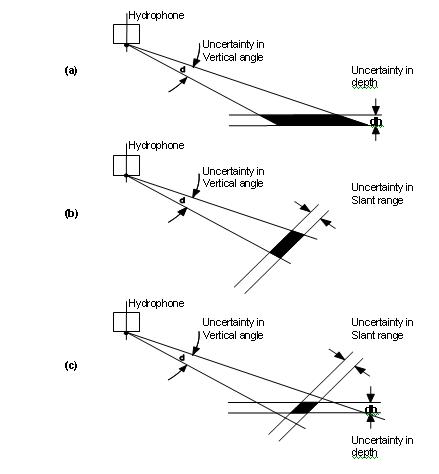
Corrections to Apparent Position
Position computed using formulas detailed above assume a motionless vessel with the transducer hydrophone array in a horizontal plane. There are a number of corrections to be applied to the "apparent" position. In describing these corrections, it is important to note here the definitions of the various reference systems involved.
The USBL Reference Point (URP)
URP is defined as the location on the vessel to which the X,Y and Z output of the USBL is referenced to. It has an associated vessel reference system in which the Yv axis is deemed to be parallel to the centreline of the vessel through the bow. The Xv axis is horizontally perpendicular to the Yv axis, and the Zv axis vertically perpendicular. The URP may be coincident with the center of the transducer array. Whether coincident with the array or not, the URP may be coincident with the vessel's centre of gravity (COG), with the vessel Reference Position, or with any other point on the vessel.
Centre of the transducer array
An associated reference system in which the Ya axis is deemed to be parallel to the centreline of the vessel through the bow. The Xa axis is horizontally perpendicular to the Ya axis, and the Za axis vertically perpendicular. The centre of transducer array may, or may not, be coincident with the URP. If it is not coincident with the URP, it is assumed that the offset between the two has been entered in the USBL System itself; in QINSy the XYZ output of the USBL is always assumed referenced to the URP.
The Local Reference System (LRS)
The origin of which is the QINSy vessel Reference Position, with the YLRS axis deemed to be parallel to the centreline of the vessel through the bow. The XLRS axis is horizontally perpendicular to the YLRS axis, and the ZLRS axis is always perpendicular to the geoid. The Reference Position may, or may not, be selected to be coincident with the URP.
In mounting a USBL transducer, the planes of the hydrophone array are oriented parallel, as far as possible, with corresponding planes of the vessel reference system, i.e. the Xa axis is coincident with the Xv, and so on. As the vessel pitches and rolls, these planes rotate about the URP. Since a vessel rotates around its centre of gravity (COG), it is good sense to locate the URP at the COG; this is the reason why the URP (USBL reference point) is coincident with the COG on many vessels. We shall assume for the sake of argument that the URP is coincident with the COG. "Apparent" position of a transponder/beacon with respect to the transducer array is given in relation to this rotating URP reference system and is expressed in terms of Xa, Ya, and Za. If the centre of the hydrophone array is coincident with the URP, Xa = Xv, Ya = Yv, and Za = Zv.
In order to translate "apparent" position into XYZ coordinates measured in the Local Reference System (LRS), the following corrections must be computed and applied to Xa, Ya, and Za to yield XLRS, YLRS, and ZLRS. These corrections compensate for:
- Vessel pitch and roll.
- Array offset from a reference point, e.g. the centre of gravity (COG).
- Array translation due to a combination of array offset and vessel pitch and roll motion.
- Subsea transponder/responder/beacon offset from the designated target.
Note
The USBL calibration program assumes that the centre of the transducer array is coincident with the URP, or that any corrections for array offset from the URP have been applied in the USBL sensor itself.
When offsets are applied, the USBL X, Y, and Z output is not referenced to the USBL-transducer but to the URP (USBL Reference Position). On many vessels the URP is coincident with the COG, which is the assumption we made earlier.
Despite the fact that QINSy uses only the XYZ output of the USBL which is referenced to the URP, and is technically uninterested in how offsets between the URP and transducer array are corrected for, it is interesting to examine these corrections for the sake of clarity.
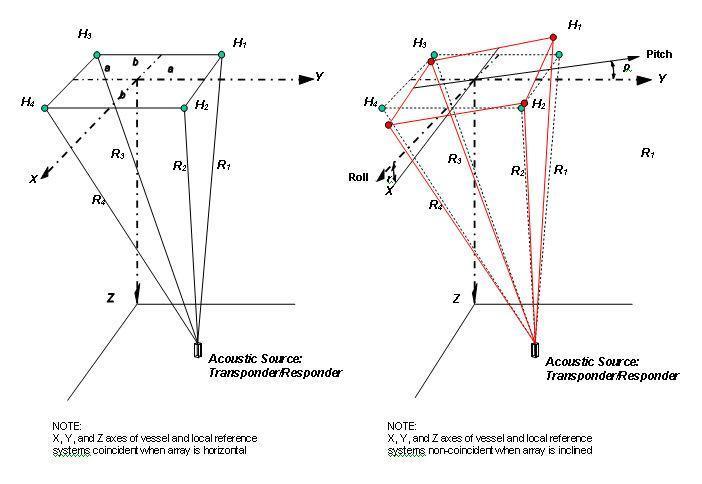
Vessel Pitch and Roll
The above figure illustrates the three dimensional geometry of the vessel-mounted hydrophone array in relation to a sub-sea acoustic source, firstly with the array horizontal and secondly with the introduction of pitch and roll. Both diagrams assume the transducer has no X/Y and Z offsets from the URP; in other words, the URP is coincident with the transducer and Xa = Xv, Ya = Yv, and Za = Zv. A vertical reference unit (VRU) is required to measure the vessel's attitude with respect to the true horizontal plane of the vessel at the same instant as the subsea acoustic measurement. Pitch and roll angles, Tp and Tr, are measured in the YZ and XZ planes of the vessel respectively; pitch as a rotation around the X-axis, roll as a rotation around the Y-axis. They are applied to correct the apparent mechanical angles of incidence.
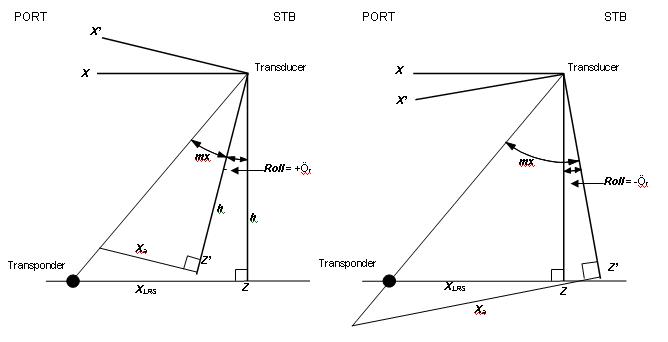
Initially considering the corrections for vessel roll only, the figure above illustrates the corrections made to both starboard and to port. If the measured angle, Tr, is considered negative when the vessel rolls to starboard and positive when the roll is to port, the corrected X coordinate is given by the expression:
XLRS = h tan(tan-1(Xa/h) - Tr) (where h = the vertical separation between transducer array and acoustic source (transponder/beacon) )
Tmx = the incidence angle measured between the Z axis of the transducer array and the acoustic source.
Xa = the "apparent" X coordinate measured perpendicular to the Z axis of the transducer array at a depth h.
XLRS = the corrected X coordinate measured perpendicular to the true Z axis through the vessel URP, at a point, h, below the transducer.
Similarly considering vessel pitch, the corrected Y coordinate is given by the following if the measured angle, Tp, is considered negative when pitch is bow down and positive when pitch is bow up:
YLRS = h tan(tan-1(Xa/h) - Tp)
Obviously errors made in measuring the pitch and roll angles, whether due to misalignment or mis-calibration of the VRU unit, will impact the computation of X, Y, Z coordinates.
Array Offset and Translation due to Vessel Motion
The centre of the transducer hydrophone array may not be coincident with the vessel reference. Where the transducer is offset from the reference, corrections additional to vessel pitch and roll must be taken into account in computations of X, Y, and Z coordinates measured between the transducer and an acoustic source. Taking the co-ordinate transformation from hydrophone array to vessel coordinates in two stages, the translation due to pitch in the YZ plane is examined first.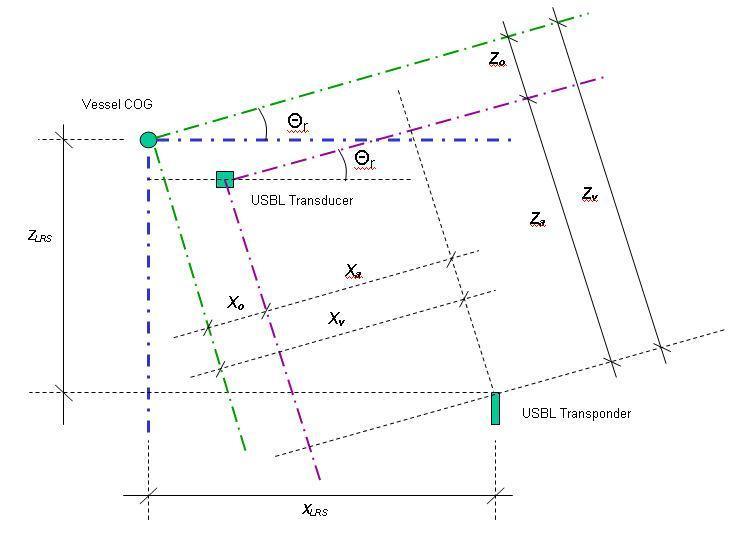
Remembering our assumption that the URP and COG are coincident, the figure above shows the centre of the transducer array offset from the URP/Vessel COG by Xo and Zo. The translation is accomplished in two stages.
Firstly a linear coordinate transformation effectively reduces the centre of transducer array back to the URP/COG.
The true X and Z coordinates are given by:
Xv = Xa + Xo
Zv = Za + Zo
where Xa = the "apparent" X coordinate measured perpendicular to the Z axis of the transducer array.
Xo = the "X" offset measured between centre of array and the vessel URP.
Xv = the "apparent" X coordinate measured perpendicular to the Z axis of the transducer array translated back to the vessel URP.
Za = the "apparent" Z coordinate measured perpendicular to the X axis of the transducer array.
Zo = the "Z" offset measured between centre of array and the vessel URP.
Zv = the "apparent" Z coordinate measured perpendicular to the axis of the transducer array translated back to the vessel URP.
The second coordinate transformation translates the array measurements into vessel coordinates, and involves the angular rotation, Tr, due to roll about the Y-axis. Vessel coordinates can be expressed as:
XLRS = XvcosTr + ZvsinTr
ZLRS = -XvsinTr + ZvcosTr
where XLRS = the corrected X coordinate measured perpendicular to the true Z axis through the vessel LRS (Local Reference System).
ZLRS = the corrected Z coordinate measured perpendicular to the true X axis through the vessel LRS.
Similar equations can be developed for vessel pitch, Tp, to yield YLRS.
Errors made in determining the offset between URP and transducer, whether due to residual errors in the installation or in measuring the actual offset, will therefore impact the computation of X, Y, Z coordinates.
